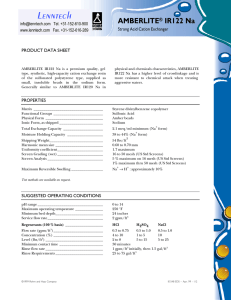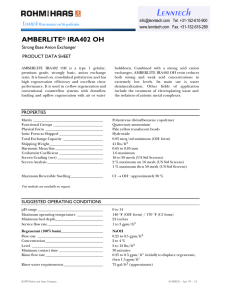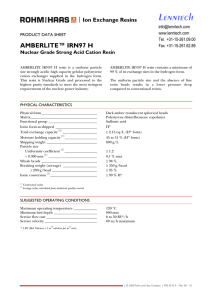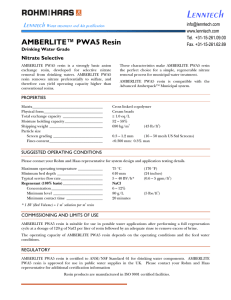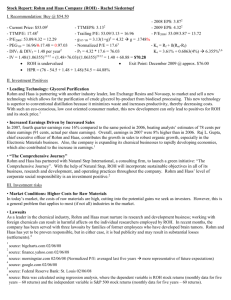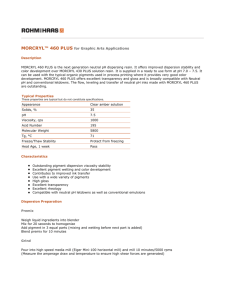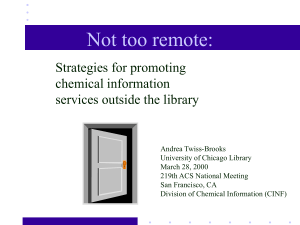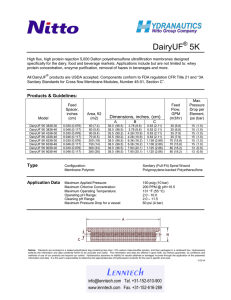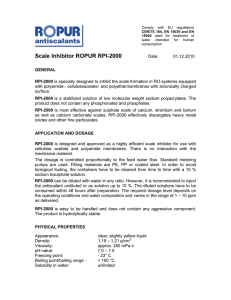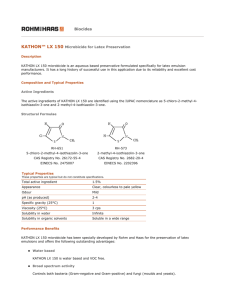AMBERLITE IR122 Na ®
advertisement
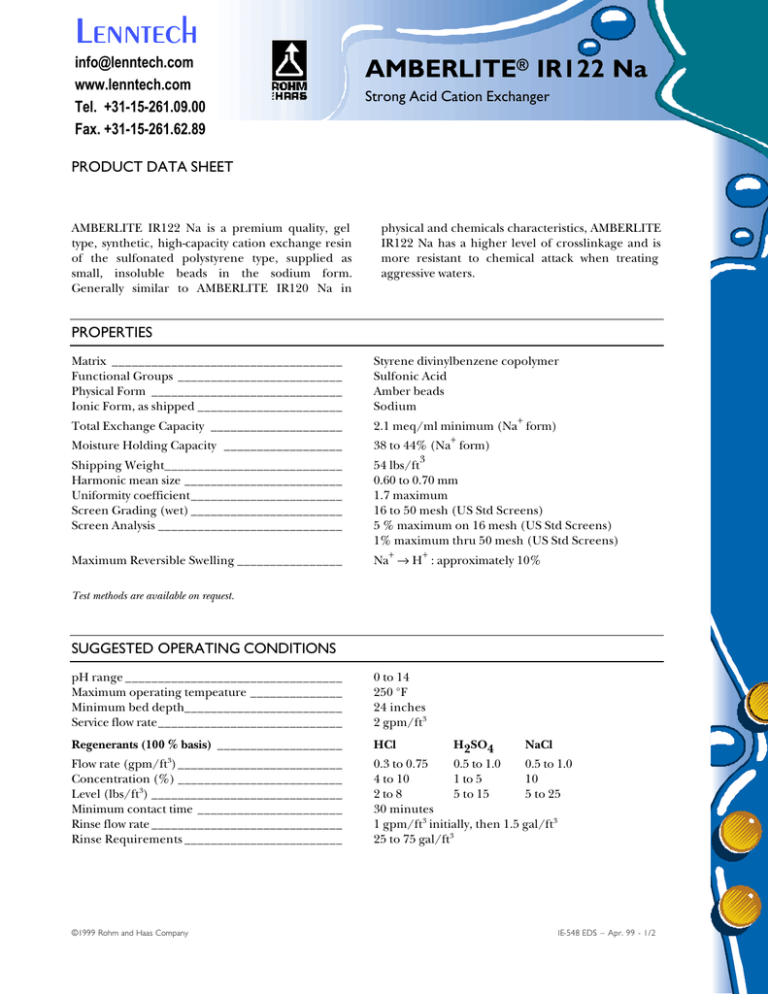
Lenntech info@lenntech.com www.lenntech.com Tel. +31-15-261.09.00 Fax. +31-15-261.62.89 AMBERLITE® IR122 Na Strong Acid Cation Exchanger PRODUCT DATA SHEET AMBERLITE IR122 Na is a premium quality, gel type, synthetic, high-capacity cation exchange resin of the sulfonated polystyrene type, supplied as small, insoluble beads in the sodium form. Generally similar to AMBERLITE IR120 Na in physical and chemicals characteristics, AMBERLITE IR122 Na has a higher level of crosslinkage and is more resistant to chemical attack when treating aggressive waters. PROPERTIES Matrix ___________________________________ Functional Groups _________________________ Physical Form _____________________________ Ionic Form, as shipped ______________________ Styrene divinylbenzene copolymer Sulfonic Acid Amber beads Sodium Total Exchange Capacity ____________________ 2.1 meq/ml minimum (Na form) Moisture Holding Capacity __________________ 38 to 44% (Na form) Shipping Weight___________________________ Harmonic mean size ________________________ Uniformity coefficient_______________________ Screen Grading (wet) _______________________ Screen Analysis ____________________________ 54 lbs/ft 0.60 to 0.70 mm 1.7 maximum 16 to 50 mesh (US Std Screens) 5 % maximum on 16 mesh (US Std Screens) 1% maximum thru 50 mesh (US Std Screens) Maximum Reversible Swelling ________________ Na → H : approximately 10% + + 3 + + Test methods are available on request. SUGGESTED OPERATING CONDITIONS pH range _________________________________ Maximum operating tempeature ______________ Minimum bed depth________________________ Service flow rate____________________________ 0 to 14 250 °F 24 inches 2 gpm/ft3 Regenerants (100 % basis) ___________________ HCl 3 Flow rate (gpm/ft )_________________________ Concentration (%) _________________________ Level (lbs/ft3) _____________________________ Minimum contact time ______________________ Rinse flow rate _____________________________ Rinse Requirements ________________________ ©1999 Rohm and Haas Company H2SO4 NaCl 0.3 to 0.75 0.5 to 1.0 0.5 to 1.0 4 to 10 1 to 5 10 2 to 8 5 to 15 5 to 25 30 minutes 1 gpm/ft3 initially, then 1.5 gal/ft3 25 to 75 gal/ft3 IE-548 EDS – Apr. 99 - 1/2 PERFORMANCE The operating capacity depends on several factors, such as the water analysis and the level of regeneration. The data to calculate the operating capacity and the ionic leakage with co-flow regeneration are given in the AMBERLITE IR122 Na Engineering Data Sheets. LIMITS OF USE AMBERLITE IR122 Na is suitable for industrial used. For other specific applications such as pharmaceutical, food processing or potable water applications, it is recommended that all potential users seek advice from Rohm and Haas Company in Fig. 1 : Pressure Drop order to determine the best resin choice and optimum operating conditions. HYDRAULIC CHARACTERISTICS Figure 1 shows the pressure drop data for AMBERLITE IR122 Na, as a function of service flow rate and water temperature. Pressure drop data are valid at the start of the service run with clear water and a correctly classified bed. Figure 2 shows the bed expansion of AMBERLITE IR122 Na, as a function of backwash flow rate and water temperature. Fig. 2 : Bed Expansion Lenntech info@lenntech.com www.lenntech.com Tel. +31-15-261.09.00 Fax. +31-15-261.62.89 AMBERLITE is a trademark of Rohm and Haas Company, Philadelphia, U.S.A. Ion exchange resins and polymeric adsorbents, as produced, contain by-products resulting from the manufacturing process. The user must determine the extent to which organic by-products must be removed for any particular use and establish techniques to assure that the appropriate level of purity is achieved for that use. The user must ensure compliance with all prudent safety standards and regulatory requirements governing the application. Except where specifically otherwise stated, Rohm and Haas Company does not recommend its ion exchange resins or polymeric adsorbents, as supplied, as being suitable or appropriately pure for any particular use. Consult your Rohm and Haas technical representative for further information. Acidic and basic regenerant solutions are corrosive and should be handled in a manner that will prevent eye and skin contact. Nitric acid and other strong oxidising agents can cause explosive type reactions when mixed with Ion Exchange resins. Proper design of process equipment to prevent rapid buildup of pressure is necessary if use of an oxidising agent such as nitric acid is contemplated. Before using strong oxidising agents in contact with Ion Exchange Resins, consult sources knowledgeable in the handling of these materials. Rohm and Haas Company makes no warranties either expressed or implied as to the accuracy or appropriateness of this data and expressly excludes any liability upon Rohm and Haas arising out of its use. We recommend that the prospective users determine for themselves the suitability of Rohm and Haas materials and suggestions for any use prior to their adoption. Suggestions for uses of our products of the inclusion of descriptive material from patents and the citation of specific patents in this publication should not be understood as recommending the use of our products in violation of any patent or as permission or license to use any patents of the Rohm and Haas Company. Material Safety Data Sheets outlining the hazards and handling methods for our products are available on request. ©1999 Rohm and Haas Company IE-548 EDS – Apr. 99 - 2/2
